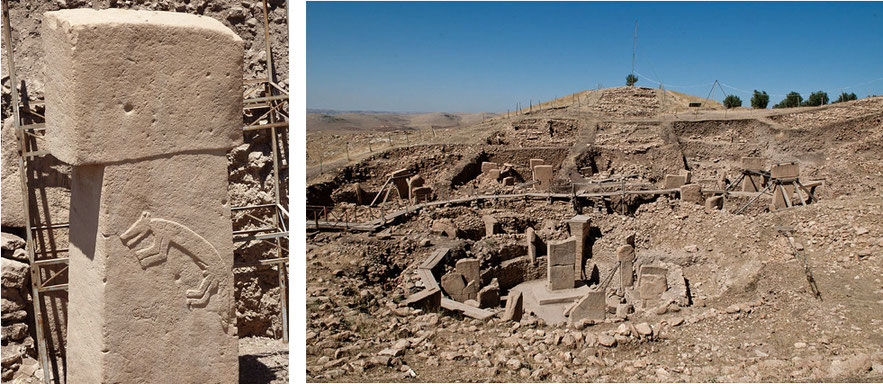
Here’s a site that upended everything we thought we knew about building, eating, drinking and living our Neolithic lives like they’re golden.
Göbekli Tepe, located in the Fertile Crescent of what was Mesopotamia and is now Turkey, is the oldest example of monumental architecture ever found. Built a staggering 11,600 years ago, the structure, interpreted by some archaeologists as a spiritually inspired place, is roughly 7,100 years older than the pyramids of Giza and 6,600 years older than Stonehenge. So what did our Neolithic friends build? Here’s our description.
Imagine if you will two beautifully sculpted, 18 foot tall “T” shaped limestone pillars situated in the center of a 32 foot diameter circle formed of eight smaller pillars. Exquisite bas-relief images of scorpions, lions and boars (oh my) are carved into the outer pillars while the two inner pillars resemble giant anthropomorphized humans. Now imagine every twenty years or so burying those lovely outside pillars, erecting some new ones closer to the center pillars, and then eventually deciding to bury the whole thing and start over a few feet away. For the next 1,000 years. Why? Who knows! That’s just one of the many mysteries of Göbekli Tepe. But, we promised you upendedness. Here goes.
The people that built Göbekli Tepe didn’t have agriculture. Before Göbekli Tepe conventional wisdom held that agriculture led to food surpluses, which led to free time, which led to collective human effort to build things, which led to civilization itself. Evidence from Göbekli Tepe, however, has led some researchers think just the opposite, hypothesizing that the monumental building project led to collective human effort to build things, which led to civilization, which led to agriculture. The Turkish Ministry of Culture and Tourism refers to Göbekli Tepe as “zero point in time” because the site potentially represents the first transition from hunting and gathering to settled agriculture in the world.
But what motivated so many people to come together and build Göbekli Tepe in the first place? Obviously with no wheels or large animals to help, it would take an enormous amount of humans to hew and move 16 ton pillars. Not to mention fill in the old circular patterns when the group was ready to build a new one. Why did they do it? No one knows. But archaeologists have uncovered large limestone vessels that, based on very preliminary analyses, they say could have contained beer. Now we're not saying that beer is the great reward upon which all human labors rest, that it needs be thanked for the very rise of civilization and agriculture - but maybe it helped.

Jennifer Riddle started her professional career as a happy field hand in the Nevada desert. She worked her way up to Principal Investigator and romped through the American Southwest and Great Basin for 15 years, stopping the romping only when she decided to join the Archaeology Almanac ranks and write articles for a living.



